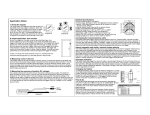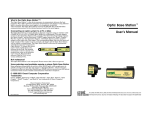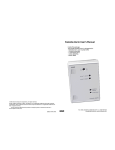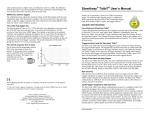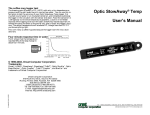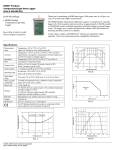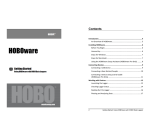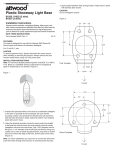Download HOBO® VOLT User`s Manual
Transcript
The coffee mug logger test Voltage (V) You can make a simple battery using coffee, a stainless steel spoon and a little bit of aluminum foil. Connect the aluminum foil to the black lead from your HOBO Volt and the yellow lead to the spoon. Place both the foil and the spoon in the coffee, making sure that the foil and the spoon do not touch. Your coffee is acidic enough to make a weak battery. The plot at the right shows the voltage output of the battery with time. We attribute the initial drop to the coffee’s cooling. Why does it rise with time, and what causes the oscillation? If you know the answers, please tell us. NSET ONSE HOBO® VOLT 0.90 0.85 User’s Manual 0.80 0.75 0.70 0.65 0.60 08:00 23Feb95 08:00 09:00 10:00 Coffee … 11:00 S/N 429 Battery Instructions In normal usage the 3.6 volt HOBO battery is expected to last two years, although it is suggested that you change the battery every year. To change the battery, remove the logger’s cover. Remove the old battery by pulling it straight away from the board. To remove the high internal resistance that builds up when this kind of battery is not in use, short the new battery for one second by touching the leads with a paper clip before installing it. When the battery first makes contact the status LED on the board should blink brightly five times. If it does not, remove the battery, wait ten seconds and try again. Finally, place the cover back on the HOBO Volt logger, lining it up so that the LED shows through the intended spot on the label. © 1996-1999, Onset Computer Corporation Trademarks Onset®, HOBO®, StowAway®, StowAway®TidbiT®, Optic Shuttle™, Optic Base Station™, Optic Coupler™, TidbiT® Coupler™, and BoxCar® are trademarks of Onset Computer Corporation. Onset Computer Corporation 470 MacArthur Blvd., Bourne, MA 02532 Mailing: PO Box 3450, Pocasset, MA 02559-3450 8:00 AM to 5:00 PM EST Tel:1-800-LOGGERS (1-800-564-4377) Tel: 508-759-9500, Fax: 508-759-9100 E-mail: [email protected] Internet: http://www.onsetcomp.com D-1584-C MAN-HV Thank you for purchasing a HOBO® Voltage logger. The HOBO Volt was designed as a general purpose voltage logger. Its accepts inputs ranging from 0 volts to 2.5 DC volts. Warning Do not apply a signal to the A-D input that is more than 0.2 volts lower than ground, or 0.2 volts higher that the battery supply (nominally 3.5 volts). Timing Diagram Calibration The HOBO Volt logger has no calibration adjustments. The accuracy is guaranteed by using precision parts. To check for possible part failures or assembly problems, each HOBO Volt logger is tested for accuracy at eight different voltages to verify that they are within specifications. Accuracy ±10 mV ± 0.5% of reading. NOTE: The HOBO Volt logger cannot store the value 0 volts, and substitutes 10 mV instead. Connection points The HOBO Volt has four connections, starting near the edge of the box: A-D input (0 to 2.5 volts, analog input); Sense line (active high, digital output); Battery supply (3.5 volt nominal, output) and Ground (output). Connect the HOBO Volt logger to the host computer using the appropriate interface cable (CABLE-PC-3.5 for a PC and CABLE-MAC-HOBO for a Macintosh). When connecting the 3.5 mm communications cable to your HOBO Volt logger make sure that it is pushed completely into the connector! You will now be able to communicate with the HOBO Volt logger using the host software. (See the software user’s manual for launch details). Recommended software: BoxCar® 3.6+ or any version of BoxCar® Pro. At the end of the deployment, reconnect your logger to the host computer for readout. The HOBO Volt logger communicates at 1200 baud. Its cleverly optimized software allows a full 2K off-load in only twenty seconds. Operating environment Time accuracy At room temperature, the logger’s idea of time can vary from the actual time by as much as one hour per year (100 ppm). There is an additional temperature effect shown in Plot A. The input is active for a fifteen millisecond period during each measurement. The actual A-D reading occurs two milliseconds after the start of this period (see timing diagram at the right). 15mS Sense Line Input characteristics Input Sample 2mS 2mS ±0.1 µA leakage max. while disconnected, ±0.4 µA while connected. Note: The sense line and analog input lines have 100K resistors in series with them to help protect them from out-of-range inputs. Battery: for unusual applications only Launch and recovery Your HOBO Volt logger will operate correctly within the temperature range -40°C to +75°C. Do not expose to an environment where condensation will form on the logger. Condensation will cause corrosion. The logger’s accuracy is specified within this range as well. Continuous exposure to temperatures above +45°C will reduce the HOBO Volt logger’s battery life. Timing The battery output line is not normally used. It connects directly to the HOBO Volt logger’s internal 3.5 volt battery which has a capacity of 370 mAHr. Drawing current from this line will reduce the life of the HOBO Volt logger’s battery. The sense output line (not normally used) This output line is high (about 3.5 volts) during the fifteen millisecond time that the HOBO Volt takes a measurement, and low at all other times. This output can be used to turn on power to an external sensor only during a measurement, thereby minimizing the sensor’s current drain. The external electonics needed to turn on power to the sensor depends on the application. An example using the Sense line Plot A Graph 1093 Timebase dependence Reed switches close in the presence of a strong magnetic field. A HOBO Volt can be used to monitor the switch closure using the circuit shown at right. When the switch is open, the input signal will follow the sense line voltage. When the switch is closed, it will stay at ground level. The 100K resistor is not really needed since there is one on the inside of the HOBO Volt logger. The average current drain of the HOBO Volt is about 20 µA and the sense line is only high for fifteen milliseconds during each measurement cycle. At a half second interval the average current drain due to the switch sensing circuit is (3.5/100,000)*(15/500) or about 1 µA, and correspondingly lower for longer intervals. Sense 100K Input Reed Switch Ground


